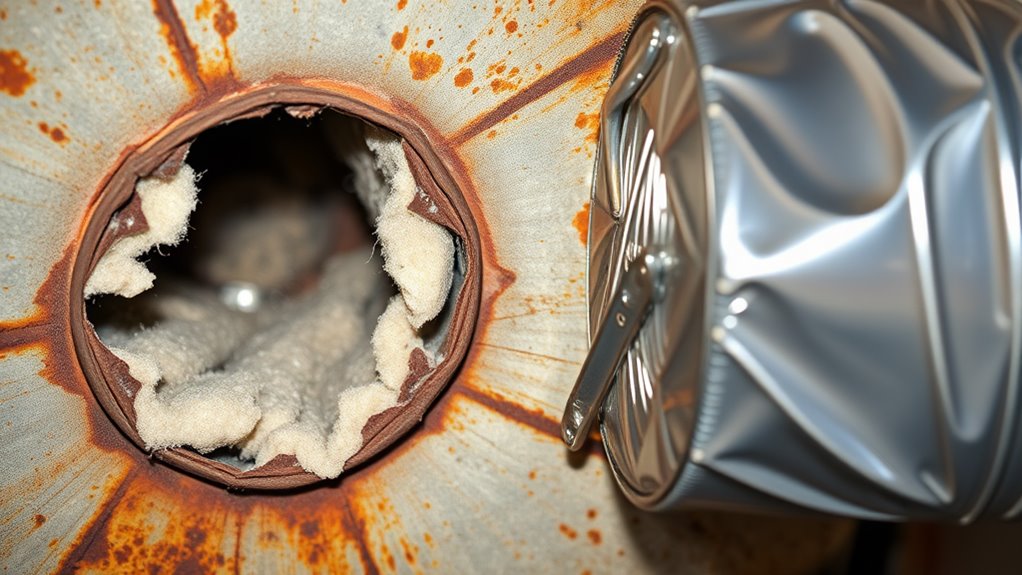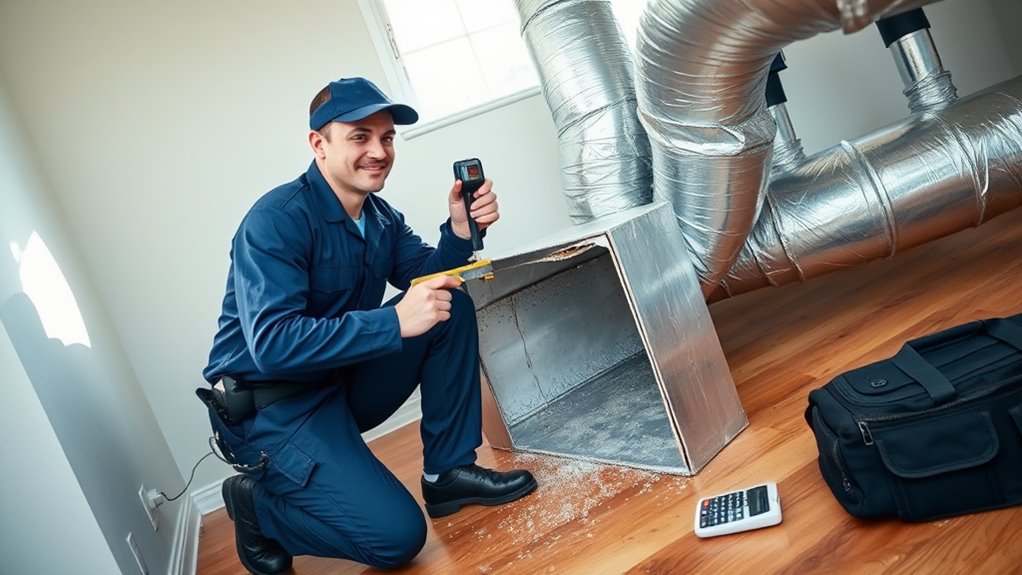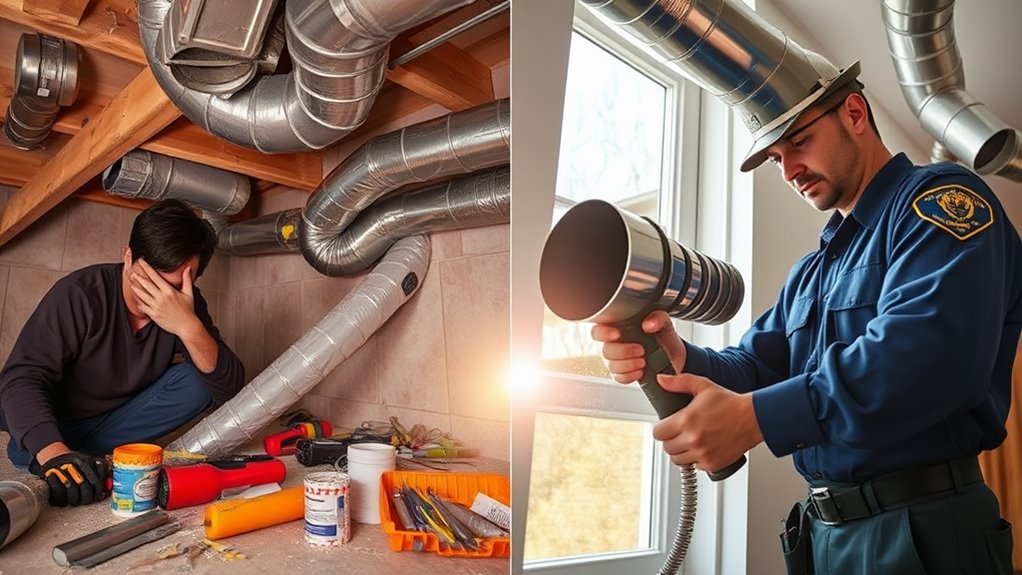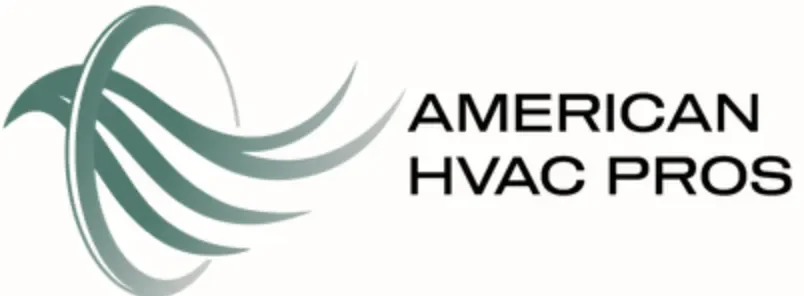Air duct repair services can address multiple issues affecting your HVAC system's performance, from inconsistent airflow to rising energy bills. You'll benefit from professional technicians who use specialized tools to detect leaks, repair damaged seals, and clean contaminated ductwork. Professional repairs typically include thorough inspections, EPA-approved sanitizing methods, and advanced leak detection techniques. Understanding the signs of duct damage and available repair options will help you maintain ideal indoor air quality and energy efficiency.
Common Signs of Air Duct Damage

Several telltale signs indicate your air ducts may need repair. If you notice inconsistent airflow between rooms, hear rattling or whistling sounds from your vents, or experience unexplained increases in energy bills, you're likely dealing with air duct leaks. Watch for visible damage like dents, disconnected sections, or corrosion in exposed ductwork.
Poor temperature regulation and excess dust accumulation throughout your home often point to compromised duct insulation or structural issues. You might also detect musty odors, which can signal moisture infiltration or mold growth within the system. Check your vents for weak airflow or debris, and pay attention to rooms that feel stuffy or take longer to heat and cool. These symptoms typically worsen over time, so it is crucial to address them promptly.
Benefits of Professional Duct Repair
Professional duct repair directly improves your home's indoor air quality by eliminating contaminants, allergens, and mold that accumulate in damaged ducts. You'll notice a significant reduction in your energy bills since repaired ducts prevent conditioned air from escaping through gaps and cracks. Your HVAC system will operate more efficiently and last longer when paired with properly sealed and maintained ductwork.
Better Indoor Air Quality
When your air ducts are properly repaired and maintained by skilled technicians, you'll experience a significant improvement in indoor air quality. Damaged ducts can harbor multiple indoor pollutants, including dust, mold spores, pet dander, and allergens that circulate throughout your home with each cycle of your HVAC system.
Professional duct repair guarantees that these contaminants are effectively removed and prevented from re-entering your living spaces. Your ventilation systems will operate at peak efficiency, filtering out harmful particles and maintaining proper airflow throughout your home. You'll notice reduced allergy symptoms, fewer respiratory issues, and a decrease in musty odors. Moreover, sealed and repaired ducts prevent outside contamination from entering through gaps or cracks, keeping your indoor environment consistently clean and healthy.
Lower Energy Consumption
Damaged or leaky air ducts can waste up to 30% of your HVAC system's energy output, considerably increasing your monthly utility bills. When you invest in professional duct repair, you'll seal these costly leaks and restore your system's energy efficiency. Your HVAC unit won't need to work as hard to maintain desired temperatures, reducing wear and tear on the equipment.
Professional duct repair guarantees conditioned air reaches its intended destinations without escaping into unused spaces like attics or crawl spaces. You'll notice immediate cost reduction as your system delivers peak performance with minimal energy waste. The repair technicians will identify and fix connection points, seal gaps, and reinforce weak areas, maximizing your system's efficiency. This targeted approach to duct maintenance translates directly into lower energy consumption and reduced utility expenses.
Extended HVAC System Life
Maintaining properly sealed and repaired air ducts greatly extends your HVAC system's operational lifespan. When your ductwork operates efficiently, it reduces the strain on your heating and cooling equipment, preventing premature system failure and costly replacements. Professional duct repairs guarantee extended system efficiency by eliminating air leaks and maintaining proper airflow throughout your home.
Key duct longevity factors include regular inspection of seals, proper insulation maintenance, and timely repairs of any damage. When you invest in professional duct repair services, you're protecting vital components like your system's blower motor and heat exchanger from excessive wear. These preventive measures help your HVAC system maintain peak performance while preventing the accumulation of dust and debris that could otherwise compromise your equipment's functionality.
Types of Air Duct Repairs
Two of the most common air duct repairs you'll encounter are fixing leaks and replacing damaged seals, which can develop at joints, connections, and corners of your ductwork. These issues often require professional sealing compounds, metal tape, or mechanical fasteners to guarantee a proper, long-lasting repair. You'll also need specialized cleaning and sanitizing methods to address mold, debris, and contaminants that can accumulate within your ducts over time.
Leaks and Damaged Seals
Leaks and damaged seals in your home's ductwork can considerably reduce HVAC efficiency by allowing conditioned air to escape into unconditioned spaces. You'll notice these issues through higher energy bills, uneven heating or cooling, and excessive dust accumulation in your home.
Several duct sealants options are available to address these problems. Professional-grade mastic sealant provides a durable, long-lasting solution for sealing joints and connections. Metallic tape, specifically designed for HVAC systems, offers another effective repair technique for smaller gaps and seams. For larger breaches, you might need sheet metal patches secured with screws and sealed with mastic.
Don't rely on standard duct tape, as it deteriorates quickly under temperature fluctuations. Instead, have a professional assess the extent of leakage and recommend appropriate sealing methods for your specific situation.
Cleaning and Sanitizing Methods
Beyond sealing and repair work, proper cleaning and sanitizing of air ducts forms a key component of thorough HVAC maintenance. You'll need professional-grade sanitizing solutions and specialized cleaning techniques to guarantee ideal results.
| Method | Application |
|---|---|
| Negative Pressure | Uses powerful vacuum systems to extract debris |
| Contact Cleaning | Employs rotating brushes to dislodge buildup |
| Chemical Treatment | Applies EPA-approved sanitizing agents |
| UV Light | Eliminates microbial growth and bacteria |
When cleaning your ducts, you'll start with mechanical removal of debris, followed by sanitization. Professional contractors use truck-mounted vacuum systems that create negative pressure while deploying rotating brushes to scrub interior surfaces. They'll then apply EPA-registered sanitizing solutions through a fogging system. For lasting protection, UV light installation can help prevent future biological contamination, guaranteeing your system maintains ideal indoor air quality.
Cost Factors for Duct Repair Services

Understanding air duct repair costs requires assessing multiple interrelated factors that impact the final price. The size and accessibility of your ductwork system, the extent of damage, and your geographic location will considerably influence repair service costs. You'll find that labor rates vary by region, while material expenses depend on the specific components that need replacement.
The complexity of repairs also affects ductwork pricing factors. You're likely to pay more for emergency services, extensive structural damage, or repairs requiring specialized equipment. Furthermore, you'll need to evaluate whether the work involves simple sealing, full section replacement, or insulation repair. The lifespan of your system and local building codes may necessitate further modifications, which can further increase your total expenses.
Inspection and Diagnostic Process
A thorough duct inspection begins with your technician performing a visual assessment of accessible components, checking for obvious damage, disconnected sections, and visible mold growth. You'll receive detailed air flow measurements taken at each register and return, using specialized equipment to evaluate system performance and identify potential blockages or restrictions. Your inspection will conclude with professional leak detection tests, which may include smoke testing or pressure measurements to pinpoint the exact locations of air loss within the ductwork system.
Visual System Assessment Methods
Professional visual assessment serves as the foundational initial step in diagnosing air duct system issues. You'll want to guarantee your technician performs a thorough visual inspection of all accessible ductwork, including main trunk lines, branch ducts, and connection points. During this process, they'll identify visible signs of damage, such as disconnected segments, holes, rust, or crushed ducts.
Your technician will use specialized diagnostic tools like high-powered LED inspection lights and articulating inspection cameras to examine areas that aren't easily visible. These tools help detect hidden issues such as mold growth, accumulated debris, or compromised duct seals deep within the system. They'll document any findings with photos and detailed notes, creating an all-encompassing assessment that'll guide the necessary repair strategy.
Testing Air Flow Quality
Following the visual inspection phase, your technician will conduct thorough airflow testing to evaluate system performance and efficiency. This essential step involves extensive air quality assessment using specialized equipment to measure airflow velocity, static pressure, and temperature differentials throughout your duct system.
Your technician will use digital manometers and anemometers for precise airflow measurement at diverse points in the ductwork. They'll analyze supply and return registers to identify potential restrictions, leaks, or balance issues. The data collected helps determine if your system meets industry standards for proper air distribution. Furthermore, they'll measure humidity levels and check for potential microbiological growth that could affect indoor air quality. These measurements provide concrete evidence of system performance and guide necessary repair recommendations.
Leak Detection Techniques
To identify potential air leaks in your ductwork system, technicians employ multiple sophisticated detection methods that work in tandem. Using ultrasonic testing, they'll detect high-frequency sounds produced by escaping air, pinpointing exact leak locations that aren't visible to the naked eye. This method's particularly effective for identifying small to medium-sized breaches in your ductwork.
Thermal imaging technology provides another layer of diagnostic precision. You'll receive detailed infrared scans that reveal temperature variations along your duct system, highlighting areas where conditioned air escapes into unconditioned spaces. When combined with smoke tests and pressure measurements, these advanced techniques create a thorough leak detection profile. Your technician will map out all found leaks, allowing for targeted repairs that enhance system efficiency and minimize energy waste.
Common Air Duct Problems and Solutions
Maintaining awareness of common air duct problems can help you identify and address issues before they escalate into costly repairs. Different duct material types, including sheet metal, fiberglass, and flexible ducting, each present unique challenges. You'll want to monitor for corrosion in metal ducts, deterioration in fiberglass systems, and tears in flexible materials.
Poor connections, loose seals, and damaged insulation often lead to air leaks and reduced efficiency. If you notice uneven heating, excessive dust, or unusual noises, it's time to schedule air quality testing. You can address minor issues like loose connections by applying mastic sealant or metal-backed tape, but more severe problems like crushed ducts or extensive mold growth require professional intervention. Regular inspection and maintenance of your ductwork will prevent most major complications.
DIY Vs Professional Duct Repair

While some air duct repairs can be handled as DIY projects, others require professional expertise and specialized equipment. You can tackle simple tasks like replacing air filters, sealing small gaps with mastic sealant, or cleaning accessible ductwork sections using DIY techniques. However, complex issues demand professional intervention.
Professional expertise becomes essential when dealing with deep-system contamination, major ductwork modifications, or addressing airflow problems that affect your HVAC system's efficiency. Licensed technicians possess the tools and knowledge to perform pressure testing, video inspections, and thorough system diagnostics. They'll guarantee repairs comply with local building codes and maintain proper system balance. For extensive damage, mold remediation, or when working with asbestos-containing materials, always opt for certified professionals to protect your safety and investment.
Preventive Maintenance Tips
Regular preventive maintenance of your air duct system extends its lifespan and guarantees peak performance throughout the year. You'll need to schedule regular inspections and perform routine cleaning to maintain ideal airflow and system efficiency.
| Maintenance Task | Frequency | Benefits |
|---|---|---|
| Visual Inspection | Monthly | Identifies leaks and damage |
| Filter Replacement | Every 3 months | Improves air quality |
| Deep Cleaning | Annually | Removes debris buildup |
To enhance your system's performance, you should inspect ductwork seals, check for visible damage, and listen for unusual sounds. Don't forget to clean vent covers and registers monthly. If you notice excessive dust, unusual odors, or inconsistent airflow, it's time to schedule a professional inspection. Remember to document all maintenance activities and keep records of filter changes for ideal system tracking.
Health Impacts of Damaged Ductwork
Damaged ductwork poses significant health risks to building occupants through compromised indoor air quality. When your ducts develop leaks, cracks, or deteriorate, they'll allow contaminants like dust, mold spores, and harmful particles to circulate throughout your living space. This infiltration can trigger respiratory issues and increase allergen exposure for everyone in your home.
You'll notice the effects through persistent symptoms such as coughing, wheezing, and aggravated asthma conditions. The situation becomes particularly concerning for vulnerable individuals, including children, elderly residents, and those with pre-existing health conditions. The accumulation of moisture in damaged ducts can also create breeding grounds for bacteria and fungi, leading to more severe health complications over time. It's essential to address duct damage promptly to protect your household's respiratory health.
Energy Savings Through Duct Repairs
Leaking or inefficient ductwork can waste up to 30% of your HVAC system's energy output, resulting in considerably higher utility bills. Professional duct repairs directly impact your home's energy efficiency by sealing air leaks, reinforcing connections, and optimizing airflow distribution.
You'll notice immediate cost savings when your conditioned air reaches its intended destinations instead of escaping into unused spaces like attics or crawl spaces. A properly sealed duct system reduces your HVAC system's workload, extending its lifespan and decreasing maintenance needs. Furthermore, you'll benefit from more consistent temperatures throughout your home as repaired ducts deliver air more effectively to each room. The investment in duct repairs typically pays for itself through reduced energy consumption within one to two heating and cooling seasons.
Frequently Asked Questions
How Long Does a Typical Air Duct Repair Service Appointment Take?
Your repair time typically ranges from 2-4 hours, though it varies based on the complexity of the issue and your duct system's layout. You'll find that service efficiency depends on factors like accessibility, the type of repair needed, and whether supplementary problems are uncovered during inspection. If you're dealing with simple repairs like sealing or patching, you can expect shorter durations, while complete duct replacements may take a full day.
Can Duct Repair Services Be Performed During Winter Months?
Yes, you can have your duct repair services performed during winter months. In fact, it's often recommended as part of your winter preparation strategy. While technicians will need to temporarily shut off your heating system during repairs, they'll work efficiently to minimize indoor temperature disruption. You'll benefit from improved heating efficiency and air quality once repairs are complete, making duct maintenance particularly valuable during the cold season.
Will Pets Need to Be Contained During Duct Repair Work?
You'll need to implement pet safety measures during any in-home repair work by containing your pets in a secure room or area. This prevents them from accessing work zones, inhaling debris, or becoming stressed by unfamiliar activities. It's recommended to use pet gates, closed doors, or temporary containment measures like kennels. You should also inform technicians about your pets beforehand so they can take extra precautions while entering and exiting work areas.
Are Air Duct Repair Services Covered by Standard Home Insurance?
Your standard home insurance typically won't cover air duct repairs unless they're damaged by a covered peril like storms, fires, or falling objects. Regular wear and tear, which causes most duct issues, isn't included in basic policies. You'll need to pay repair costs out-of-pocket, which can range from $200-$900 depending on damage extent. Consider adding specific HVAC coverage to your policy or getting a home warranty for better protection.
What Certifications Should I Look for When Hiring Duct Repair Technicians?
When hiring duct repair technicians, you'll want to look for NATE (North American Technician Excellence) certification as the industry's gold standard. Furthermore, verify they hold NADCA (National Air Duct Cleaners Association) certification. Technician qualifications should include EPA Section 608 certification for handling refrigerants. For top-tier expertise, seek professionals with certification standards from ACCA (Air Conditioning Contractors of America) and relevant state licenses for HVAC work.

